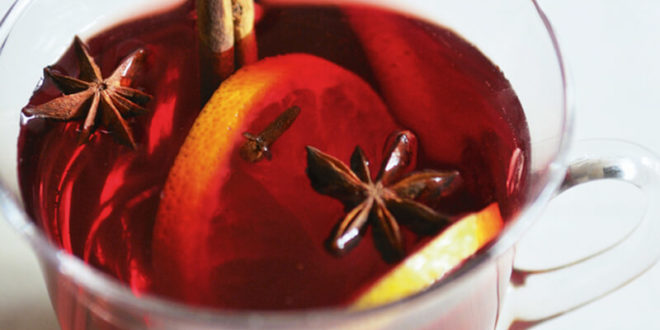A classic tipple for winter from our wine expert, Jerome Harlington.
Sit back and enjoy Christmas in a glass, with the perfect recipe for Mulled Wine.
I enjoy reading ‘The Conversation’, an independent source of news analysis and informed comment written by academic experts, working with professional journalists. Rarely are there articles about wine, but I was delighted to come across, the other day, a recent article including the history of wine and, at this time of year, as I write six weeks before Christmas, it got me thinking about the often derided and looked down upon by wine snobs – Mulled Wine. It actually has a fascinating history and story to tell.
When the temperature drops, I like to stave off the chill with a big steaming pot of mulled wine, and fill the home with the comforting aroma of red wine, citrus and spice.
The mention of mulled wine conjures images of winter-wonderland and white-Christmas scenes.
Its long history incorporates both pagan and Christian lore, traverses old and new worlds and established it as a favourite Christmastime beverage, travellers’ tipple of choice and a tonic of sorts in times of convalescence.
Whether for festivity or fortification, mulled wine has been around for at least 2,000 years.
The ancient Greek version of mulled wine, Ypocras or Hippocras, takes its name from Hippocrates, the Greek physician regarded as the father of medicine. (It is also the name of the apothecary’s bag or sieve used to strain this wine.)
Early versions of mulled wine can be found as far back as Ancient Greece. Wine played an important role in medicine in Greek antiquity. In the only ancient cookery book surviving to our times, De re coquinaria, we see a few versions of spice wine (conditum paradoxum) and wine with honey and pepper.
The latter, known as conditum melizomum viatorum was recommended for travellers: the honey and spices acted as a preservative, allowing the alcohol to accompany travellers on long journeys.
Conditum paradoxium became a prominent feature of the Saturnalia Festival in ancient Rome: the winter solstice celebration of the passing of the shortest day of the year and the rebirth of the Sun.
Conditum paradoxium was a prominent feature of the Roman winter festival, Saturnalia.
By the time of the late-Roman Republic, Saturnalia had grown from a one-day celebration to a week-long festival held each year from December 17 to 23. Consuming the warming wine as part of the celebrations was thought to help ward off winter illness and so became firmly associated with the December celebrations.
Towards the end of the 4th century, this pagan solstice celebration became interwoven with Christianity and the celebration of Christmas Day. By the middle ages, mulled wine had become entrenched as part of the festivities throughout Europe.
According to several medieval cookbooks the most common of the sweet, spiced wines in the late middle-ages were still referred to as hippocras, with the term “mulled wine” coming later.
Just as they do today, ingredients varied depending on the region, but key components were hot red wine blended with sugar and ground spices – usually ginger, cinnamon and pepper and sometimes nutmeg and cloves.
Mulled wine has been with us for millenia and whilst there’s a place for the convenience of ‘ready made’ bottles at the supermarket, I would urge you to have a go at making your own.
Here are my tips for preparing the perfect mulled wine:
Although you wouldn’t particularly want to use your best red wines, I would avoid using the cheapest bottles. Only when you heat the wine, you are left with the base wine, and if it’s of particularly poor quality, the flavour will be equally poor. There may also be unpleasant chemicals and additives that you may want to avoid.
I would recommend a medium to light bodied inexpensive red. Such as Valpolicella or Corbieres.
Remember not to boil the wine at any point, otherwise this will make your mulled wine taste bitter.
Add the bottle of red wine to the pan with an equal quantity of orange juice, preferably freshly squeezed, or if from concentrate mix it with some water.
With the added spices, I would recommend keeping these whole, otherwise your mulled wine could taste powdery, so use whole cinnamon rather than powder for example. You could try cinnamon sticks, ginger, nutmeg and a clove studded orange.
Method:
- Pour the wine into a large saucepan and add 500ml orange juice (plus water if from concentrate)
- Add orange with cloves, spices and heat gently until almost boiling
- Reduce the heat as low as possible – the liquid should barely tremble – and simmer for about 30 minutes so the spices infuse
- Add measures of brandy or whisky to taste
- Ladle into small cups or glasses to serve
If you have any questions about your Christmas wine selections or would like some help with placing an order, do drop me a line – thameout@trailblazingwine.com.
Happy exploring!
Jerome
07886 916857
You can read more articles like this one in the latest edition of Thame Out.
 Thame Out The complimentary magazine for the Thame area
Thame Out The complimentary magazine for the Thame area


